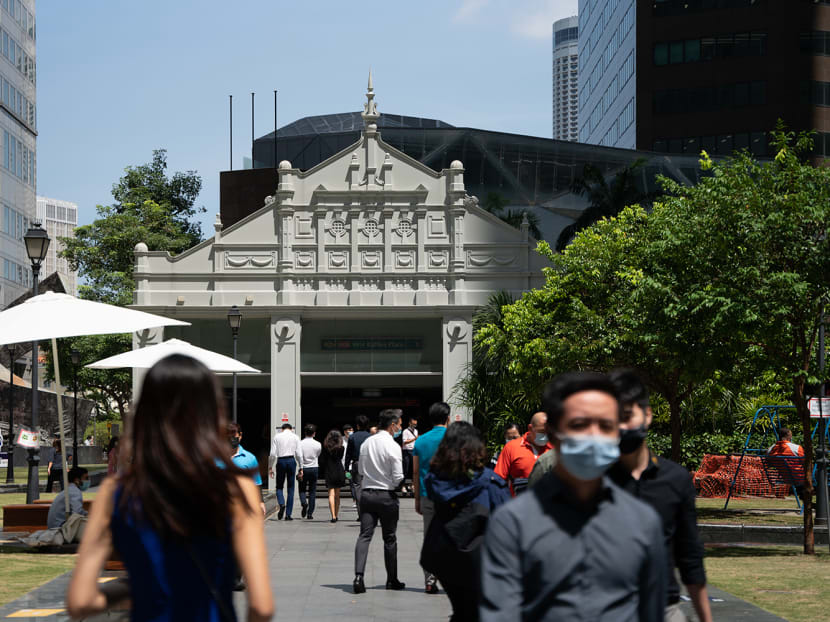Labour market continues recovery in Q4, as non-resident employment rises for first time since Covid-19 struck
SINGAPORE — The labour market continued to recover from the pandemic in the final three months of last year, as non-resident employment rose for the first time since Covid-19 struck Singapore. Resident employment grew at a faster pace than the quarter before as well, the Ministry of Manpower (MOM) said on Friday (Jan 28).

Office workers seen at the Central Business District in Singapore.
- The latest estimates of the labour market here found that total employment grew in the fourth quarter of 2021 after declining in the third quarter
- Non-resident employment rose in the fourth quarter for the first time since Covid-19 struck Singapore
- Resident employment grew at a faster pace than the quarter before due to year-end seasonal hiring
- The unemployment rate also improved as the economic growth picked up momentum in the same quarter
- The labour market is expected to continue improving in 2022 but the recovery will be uneven across sectors, MOM said
SINGAPORE — The labour market continued to recover from the pandemic in the final three months of last year, as non-resident employment rose for the first time since Covid-19 struck Singapore. Resident employment grew at a faster pace than the quarter before as well, the Ministry of Manpower (MOM) said on Friday (Jan 28).
A resident employee is a Singapore citizen or permanent resident, while non-resident employees refer to foreigners working here.
MOM's labour market advance release showed that total employment grew in the fourth quarter of last year to 47,400, after declining by 2,400 in the third quarter.
This was due to higher employment numbers among both residents and non-residents across all industries.
The unemployment rate also improved in the quarter as Singapore's economic growth picked up momentum despite the global surge of the Omicron coronavirus strain, MOM said.
For the full year, total employment saw an encouraging rebound of 40,800 after the sharp
decline of 166,600 in 2020.
This rebound was due to a smaller decline in non-resident employment last year and stronger resident employment growth throughout the year.
“We expect the labour market to continue to improve in 2022, driven by an overall easing in domestic Covid-19 restrictions and the resumption of international travel," MOM added.
"However, recovery to pre-Covid state continues to be uneven across sectors, and uncertainty remains over the trajectory of the virus."
RESIDENT EMPLOYMENT
MOM said that the increase in resident employment in the last quarter of 2021 reflects seasonal hiring due to the year-end festivities in industries such as food-and-beverage and retail services.
Employment in these sectors also grew for the first time after declines in the first three quarters of 2021.
Resident employment continued to grow steadily in outward-oriented sectors such as information and communications and financial services in the fourth quarter.
This was driven by the strong demand for digital solutions and games and software publishing activities, MOM said.
Resident and non-resident full year employment change figures will be published in the Labour Market Report 2021, released in mid-March.
NON-RESIDENT EMPLOYMENT
Though there was muted growth of non-resident employment across most sectors, there was a considerable increase of employment of non-residents in the construction sector due to the resumption of entry approvals for fully vaccinated workers in the construction, marine shipyard and process sector to enter the country from early November, MOM said.
While this was a positive turnaround from the contractions seen in preceding quarters, the growth was not enough to make up for the declines in non-resident employment in the first three quarters.
UNEMPLOYMENT AND RETRENCHMENT
- The overall unemployment rate fell from November to December 2021 by 0.1 percentage point to 2.4 per cent
- Resident unemployment rate remains unchanged at 3.2 per cent
- Citizen unemployment rate declined from 3.5 per cent in November to 3.4 per cent in December
MOM said that the unemployment situation continued to improve, although annual rates remained above pre-pandemic levels. In 2021:
- The overall unemployment rate fell to 2.6 per cent from 3 per cent in 2020
- The resident unemployment rate dropped to 3.5 per cent from 4.1 per cent in 2020
- The citizen unemployment rate declined to 3.7 per cent from 4.2 per cent in 2020
Retrenchments also remained low, as the number of layoffs last year fell significantly to 7,820 from 26,110 in 2020.
MOM said that reorganisation and restructuring of companies were common reasons for retrenchments in 2021 compared with in 2020, when the recession and business downturn were more commonly given as reasons by employers.
Retrenchments also declined most significantly in the services sector, which saw a sizeable number of layoffs in 2020, particularly in consumer-facing, aviation- and tourism-related industries.
RECOVERY EXPECTED TO CONTINUE INTO 2022
Alongside the projected economic growth, the labour market is expected to continue on its recovery trajectory in 2022, driven by the easing of domestic Covid-19 restrictions and the resumption of international travel, MOM said.
However, recovery to a state before the pandemic will likely be uneven across sectors as uncertainty remains over the coronavirus situation, the ministry added.
“Adopting a risk-managed approach in border control measures has allowed our non-resident workforce to rebound to a small degree after two years of sharp decline. We expect the non-resident workforce numbers to recover further in 2022."
The resident workforce fared well in 2021, with overall resident employment growing much quicker than in 2020 and unemployment rates coming down steadily, the ministry added.
"The Government and our tripartite partners will continue to support our workers and businesses, so that we can achieve labour market recovery as the economy and businesses restructure."











